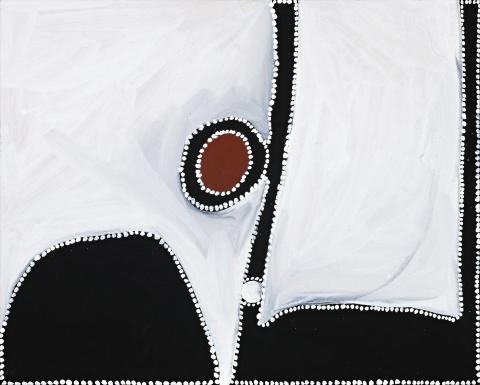UNTITLED (EMU DREAMING), 2003
PADDY NYUNKUNY BEDFORD
ochres and pigment with synthetic binder on composition board
79.0 x 98.0 cm
inscribed verso: artist's initials, title, Jirrawun Arts cat. PB CB-8-2003-2
Jirrawun Arts, Kununurra, Western Australia
Private collection, Queensland
Bedford’s sparse compositions, with their large areas of monochrome separated by subtly dotted lines, often resemble those of Warmun’s most celebrated artist Rover Thomas. But, as is also true of Thomas’s work, ‘the apparent abstraction or minimalism of Bedford’s canvases is superficial, covering a richly layered portrait of country, Ngarrangkarni and history, the significance of which is revealed through the accompanying narrative.’1
In Untitled (Emu Dreaming), 2003 the seemingly abstract qualities of Bedford’s painting style also reveals the story of the ancient ancestral Emu, who after an argument with the Bush turkey gets herself lodged in a crevice between two hills. In an interview with Frances Koford, Bedford recalls the story: ‘The emu came travelling with people from the west, from Tableland Station country, they came along through the gaps in the hills. Then the emu got stuck when she came down the hill there (at Mount King). She was stuck like that then when the turkey kept going. The turkey went on through the gap down to the open country and made camp. The emu got stuck for good because she took a sulk when the turkey stopped. If that had not happened we would have been walking in constant daylight, day after day. Good job the turkey made the law for us so that we can make camp at night.’2 Indeed, the work’s fluent structure reveals how the site is retained not just as living communal memory but in the landscape. The exact spot where the ancestral Emu became stuck in the cleft of the gorge is represented by the white dot to the lower centre of the canvas.
The allegorical nature of such stories may yield a multiplicity of interpretations, which spatially interconnect sites in country. For instance, the Emu Dreaming in Paddy Bedford’s father’s country forms part of an ancestral path connected to the Bush Turkey site, more than twenty kilometres to the north, or at least one day’s walk along the escarpment of the Durack Ranges.
1. Kjellgren, E., ‘Paddy Bedford’, in Perkins, H. and Pinchbeck, C., Tradition Today: Indigenous Art in Australia, Art Gallery of New South Wales, Sydney, 2014, p. 24
2. Interview with Koford, F., in Storer, R., Paddy Bedford, Museum of Contemporary Art, Sydney, 2006, p. 98
CRISPIN GUTTERIDGE
